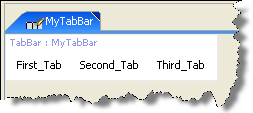Tab bars
A tab bar contains a set of tabs that run across the top of the application window, as in the following example:

You can do the following:
You can also configure the individual tabs on a tab bar. For more information, see Tabs.
Configure the default tab bar
About this task
PolicyCenter
defines a default tab bar named TabBar.
If no other tab bar is specified, then the default tab bar is used. However,
if necessary, you can explicitly specify a different tab bar to show
instead.
We recommend that you rely entirely on the default tab bar within the primary PolicyCenter application. You can customize the default tab bar to have it serve almost all of your needs. Consider defining a new tab bar only for special pages, such as entry points that have limited access to the rest of the application.
Specify which tab bar to display
About this task
You rarely need to explicitly specify a tab
bar to display. Instead, you almost always rely on the default tab bar
TabBar. However, to override
the default and specify a different tab bar, set the tabBar attribute on the location
group. For example, you could set it to MyTabBar().
As you navigate to a location, PolicyCenter scans up the navigation hierarchy and checks whether a tab bar is explicitly set on a location group. If so, then that tab bar is used. If no tab bars are set, then the default tab bar is used.
For user interface clarity and consistency, we recommend that you set the tab bar only on the top-most location group in the hierarchy. However, a tab bar set on a child location group overrides the setting of its parent.
Define a tab bar
About this task
Define a tab bar with the TabBar PCF element. For example:

